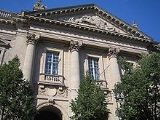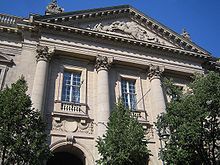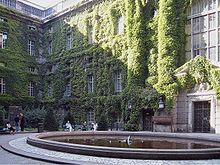
Berlin State Library
Encyclopedia
The Berlin State Library is a library in Berlin
, Germany
and a property of the Prussian Cultural Heritage Foundation
.
8, House 2 in Potsdamer Straße 33 and the newspaper archive in a former warehouse in the Westhafen harbour of Berlin.

 The Berlin State Library was founded in 1661 by Frederick William of Brandenburg
The Berlin State Library was founded in 1661 by Frederick William of Brandenburg
as "Churfürstliche Bibliothek" at Cölln an der Spree
. In 1701, the library was renamed "Royal Library at Berlin" and kept this name until the end of monarchy in Germany in 1918, then renamed to "Prussian State Library".
On May 10, 1933 not far from the library a book burning
ceremony was held by members of the Deutsche Studentenschaft (a rightist student association), also attended by S.A.
("brownshirts") and Nazi youth groups
, at Bebelplatz
on the instigation of the Propaganda Minister, Joseph Goebbels
. The Nazis burned around 20,000 books, most of which were taken from the neighbouring University – none from the Prussian State Library – including works by Thomas Mann
, Erich Maria Remarque
, Heinrich Heine
, Karl Marx
and many other authors. Today a glass plate set into the Bebelplatz, giving a view of empty bookcases, commemorates this event.
During World War II
most of the holdings (at the time some three million books and other materials) were hidden to safety in 30 monasteries, castles and abandoned mines. A part of its collections were returned to the original Berlin site at Unter den Linden
(East Berlin
) after 1945, and some relocated items, which happened to be stored in the now western occupation zones by the end of the war, were gathered in Marburg upon Lahn
and later opened to the public as Hessian and then West German Library (Hessische resp. Westdeutsche Bibliothek). These holdings were relocated to West Berlin in the late 1970s in the new building now called House 2.
Many items of the collection are located in Poland
and the territories of the former Soviet Union
, such as the Berlinka
collection, which were declared to be war reparations by the Polish state.
From 1992 on, the reunited Berlin State Library – Prussian Cultural Heritage provides a service at both its sites in the district of Mitte
– Unter den Linden 8 and Potsdamer Straße 33.
The Berlin State Library, along with two other German institutions, the Beethoven-Haus and the Deutsches Rundfunkarchiv, also holds the autograph score, autograph leaves, and historic records for Ludwig van Beethoven
's Symphony no 9, d minor, op. 125
, which was inscribed on UNESCO
’s Memory of the World Register in 2001.
' Wings of Desire
. Two angels, the stars of the film, read the thoughts of the library's patrons.
Berlin
Berlin is the capital city of Germany and is one of the 16 states of Germany. With a population of 3.45 million people, Berlin is Germany's largest city. It is the second most populous city proper and the seventh most populous urban area in the European Union...
, Germany
Germany
Germany , officially the Federal Republic of Germany , is a federal parliamentary republic in Europe. The country consists of 16 states while the capital and largest city is Berlin. Germany covers an area of 357,021 km2 and has a largely temperate seasonal climate...
and a property of the Prussian Cultural Heritage Foundation
Prussian Cultural Heritage Foundation
The Prussian Cultural Heritage Foundation , headquartered in Berlin, Germany, is one of the largest cultural institutions in the world. It was founded by a West German federal law passed on 25 July 1957, with the mission to acquire and protect the cultural legacy of the former state of Prussia...
.
Buildings
The State Library runs several premises, three of which are open for users, namely House 1 in Unter den LindenUnter den Linden
Unter den Linden is a boulevard in the Mitte district of Berlin, the capital of Germany. It is named for its linden trees that line the grassed pedestrian mall between two carriageways....
8, House 2 in Potsdamer Straße 33 and the newspaper archive in a former warehouse in the Westhafen harbour of Berlin.
- House 1, then known as the Prussian Royal Library , was built between 1908 and 1913 by the Prussian Construction and Financial Direction of Berlin, then responsible for public constructions in that city. The building is known for its Neo Baroque architecture, following a design of the popular WilhelmineWilhelmineWilhelmine is a term for the period of German history, also known as the German Empire. The term Wilhelmine Germany refers to the period running from the proclamation of Wilhelm I as German Kaiser at Versailles in 1871 to the abdication of his grandson Wilhelm II in 1918.Although the father of...
architect Ernst Eberhard von Ihne, adapted by Alexander BaerwaldAlexander BaerwaldAlexander Baerwald was a German Jewish architect best known for his work in Haifa, Israel.Baerwald was born in Berlin, Germany on 3 March 1877. He studied at the Technische Hochschule Charlottenburg , interrupted by the summer semester 1898 at the Technische Hochschule of Munich...
, who was in charge of the construction management. After the division of Berlin, it turned out to be in East BerlinEast BerlinEast Berlin was the name given to the eastern part of Berlin between 1949 and 1990. It consisted of the Soviet sector of Berlin that was established in 1945. The American, British and French sectors became West Berlin, a part strongly associated with West Germany but a free city...
. - House 2 was the new building designed by Hans ScharounHans ScharounBernhard Hans Henry Scharoun was a German architect best known for designing the Berlin Philharmonic concert hall and the in Löbau, Saxony. He was an important exponent of Organic architecture....
in the KulturforumKulturforumThe Kulturforum is a collection of cultural buildings in Berlin, Germany. It was built up in the 1950s and 60s at the edge of West Berlin, after most of the once unified city's cultural assets had been lost behind the Berlin Wall...
on Potsdamer Straße in West BerlinWest BerlinWest Berlin was a political exclave that existed between 1949 and 1990. It comprised the western regions of Berlin, which were bordered by East Berlin and parts of East Germany. West Berlin consisted of the American, British, and French occupation sectors, which had been established in 1945...
, built between 1967 and 1978 for those parts of the library's evacuated holdings which happened to be in one of the western occupation zones by the end of World War II. - The old Royal Library building, nicknamed for its design Kommode (dresser or commode), is located at the BebelplatzBebelplatzThe Bebelplatz is a public square in the central Mitte district of Berlin, the capital of Germany.The square is located on the south side of the Unter den Linden boulevard, a major east-west thoroughfare in the city centre...
. It was built by Georg Christian Unger after a design by Joseph Emanuel Fischer von ErlachJoseph Emanuel Fischer von ErlachJoseph Emanuel Fischer von Erlach, also Fischer von Erlach the younger was an Austrianarchitect of the baroque, Rococo and baroque classicism.-Life and career:...
between 1775 and 1780. It housed the library until 1914 when it moved to House 1. Now it houses the Faculty of Law of the Humboldt University.
History


Frederick William, Elector of Brandenburg
|align=right|Frederick William was Elector of Brandenburg and Duke of Prussia – and thus ruler of Brandenburg-Prussia – from 1640 until his death. A member of the House of Hohenzollern, he is popularly known as the "Great Elector" because of his military and political prowess...
as "Churfürstliche Bibliothek" at Cölln an der Spree
Cölln
In the 13th century Cölln was the sister town of Old Berlin , located on the southern Spree Island in the Margraviate of Brandenburg. Today the island is located in the historic core of the central Mitte locality of modern Berlin...
. In 1701, the library was renamed "Royal Library at Berlin" and kept this name until the end of monarchy in Germany in 1918, then renamed to "Prussian State Library".
On May 10, 1933 not far from the library a book burning
Book burning
Book burning, biblioclasm or libricide is the practice of destroying, often ceremoniously, books or other written material and media. In modern times, other forms of media, such as phonograph records, video tapes, and CDs have also been ceremoniously burned, torched, or shredded...
ceremony was held by members of the Deutsche Studentenschaft (a rightist student association), also attended by S.A.
Sturmabteilung
The Sturmabteilung functioned as a paramilitary organization of the National Socialist German Workers' Party . It played a key role in Adolf Hitler's rise to power in the 1920s and 1930s...
("brownshirts") and Nazi youth groups
Hitler Youth
The Hitler Youth was a paramilitary organization of the Nazi Party. It existed from 1922 to 1945. The HJ was the second oldest paramilitary Nazi group, founded one year after its adult counterpart, the Sturmabteilung...
, at Bebelplatz
Bebelplatz
The Bebelplatz is a public square in the central Mitte district of Berlin, the capital of Germany.The square is located on the south side of the Unter den Linden boulevard, a major east-west thoroughfare in the city centre...
on the instigation of the Propaganda Minister, Joseph Goebbels
Joseph Goebbels
Paul Joseph Goebbels was a German politician and Reich Minister of Propaganda in Nazi Germany from 1933 to 1945. As one of Adolf Hitler's closest associates and most devout followers, he was known for his zealous oratory and anti-Semitism...
. The Nazis burned around 20,000 books, most of which were taken from the neighbouring University – none from the Prussian State Library – including works by Thomas Mann
Thomas Mann
Thomas Mann was a German novelist, short story writer, social critic, philanthropist, essayist, and 1929 Nobel Prize laureate, known for his series of highly symbolic and ironic epic novels and novellas, noted for their insight into the psychology of the artist and the intellectual...
, Erich Maria Remarque
Erich Maria Remarque
Erich Maria Remarque was a German author, best known for his novel All Quiet on the Western Front.-Life and work:...
, Heinrich Heine
Heinrich Heine
Christian Johann Heinrich Heine was one of the most significant German poets of the 19th century. He was also a journalist, essayist, and literary critic. He is best known outside Germany for his early lyric poetry, which was set to music in the form of Lieder by composers such as Robert Schumann...
, Karl Marx
Karl Marx
Karl Heinrich Marx was a German philosopher, economist, sociologist, historian, journalist, and revolutionary socialist. His ideas played a significant role in the development of social science and the socialist political movement...
and many other authors. Today a glass plate set into the Bebelplatz, giving a view of empty bookcases, commemorates this event.
During World War II
World War II
World War II, or the Second World War , was a global conflict lasting from 1939 to 1945, involving most of the world's nations—including all of the great powers—eventually forming two opposing military alliances: the Allies and the Axis...
most of the holdings (at the time some three million books and other materials) were hidden to safety in 30 monasteries, castles and abandoned mines. A part of its collections were returned to the original Berlin site at Unter den Linden
Unter den Linden
Unter den Linden is a boulevard in the Mitte district of Berlin, the capital of Germany. It is named for its linden trees that line the grassed pedestrian mall between two carriageways....
(East Berlin
East Berlin
East Berlin was the name given to the eastern part of Berlin between 1949 and 1990. It consisted of the Soviet sector of Berlin that was established in 1945. The American, British and French sectors became West Berlin, a part strongly associated with West Germany but a free city...
) after 1945, and some relocated items, which happened to be stored in the now western occupation zones by the end of the war, were gathered in Marburg upon Lahn
Marburg
Marburg is a city in the state of Hesse, Germany, on the River Lahn. It is the main town of the Marburg-Biedenkopf district and its population, as of March 2010, was 79,911.- Founding and early history :...
and later opened to the public as Hessian and then West German Library (Hessische resp. Westdeutsche Bibliothek). These holdings were relocated to West Berlin in the late 1970s in the new building now called House 2.
Many items of the collection are located in Poland
Poland
Poland , officially the Republic of Poland , is a country in Central Europe bordered by Germany to the west; the Czech Republic and Slovakia to the south; Ukraine, Belarus and Lithuania to the east; and the Baltic Sea and Kaliningrad Oblast, a Russian exclave, to the north...
and the territories of the former Soviet Union
Soviet Union
The Soviet Union , officially the Union of Soviet Socialist Republics , was a constitutionally socialist state that existed in Eurasia between 1922 and 1991....
, such as the Berlinka
Berlinka (art collection)
The Berlinka is the Polish name for a German collection of historic material which was originally kept at the Preußische Staatsbibliothek zu Berlin, the Prussian State Library at Berlin, but which is now kept in the Jagiellonian Library in Kraków....
collection, which were declared to be war reparations by the Polish state.
From 1992 on, the reunited Berlin State Library – Prussian Cultural Heritage provides a service at both its sites in the district of Mitte
Mitte
Mitte is the first and most central borough of Berlin. It was created in Berlin's 2001 administrative reform by the merger of the former districts of Mitte proper, Tiergarten and Wedding; the resulting borough retained the name Mitte. It is one of the two boroughs which comprises former West and...
– Unter den Linden 8 and Potsdamer Straße 33.
Inventory
- 10 million books
- 4,400 incunabula
- 18,300 occidentalWestern cultureWestern culture, sometimes equated with Western civilization or European civilization, refers to cultures of European origin and is used very broadly to refer to a heritage of social norms, ethical values, traditional customs, religious beliefs, political systems, and specific artifacts and...
manuscripts - 40,000 oriental manuscripts
- 250,000 autographs
- 66,350 music autographs
- 1,400 personal archives
- 450,000 editions of sheet musicSheet musicSheet music is a hand-written or printed form of music notation that uses modern musical symbols; like its analogs—books, pamphlets, etc.—the medium of sheet music typically is paper , although the access to musical notation in recent years includes also presentation on computer screens...
- 960,000 maps and atlases
- 38,000 subscription periodicals and monographMonographA monograph is a work of writing upon a single subject, usually by a single author.It is often a scholarly essay or learned treatise, and may be released in the manner of a book or journal article. It is by definition a single document that forms a complete text in itself...
ic series - 180,000 early newspaper volumes and 400 subscription newspapers
- Diverse electronic databases
- 2.3 million microfiches and microfilms
- 13.5 million images in the picture archive
The Berlin State Library, along with two other German institutions, the Beethoven-Haus and the Deutsches Rundfunkarchiv, also holds the autograph score, autograph leaves, and historic records for Ludwig van Beethoven
Ludwig van Beethoven
Ludwig van Beethoven was a German composer and pianist. A crucial figure in the transition between the Classical and Romantic eras in Western art music, he remains one of the most famous and influential composers of all time.Born in Bonn, then the capital of the Electorate of Cologne and part of...
's Symphony no 9, d minor, op. 125
Symphony No. 9 (Beethoven)
The Symphony No. 9 in D minor, Op. 125, is the final complete symphony of Ludwig van Beethoven. Completed in 1824, the symphony is one of the best known works of the Western classical repertoire, and has been adapted for use as the European Anthem...
, which was inscribed on UNESCO
UNESCO
The United Nations Educational, Scientific and Cultural Organization is a specialized agency of the United Nations...
’s Memory of the World Register in 2001.
Notable librarians
Several notable scholars have held positions at the library, among them:- Georg Heinrich PertzGeorg Heinrich Pertzthumb|Georg Heinrich PertzGeorg Heinrich Pertz , was a German historian born at Hanover.From 1813 to 1818 he studied at the University of Göttingen, chiefly under A. H. L. Heeren...
- Valentin RoseValentin Rose (classicist)Valentin Rose was a German classicist and textual critic.-Personal life:Valentin Rose was the son of mineralogist Gustav Rose , and a nephew to famed mineralogist Heinrich Rose and to the pharmacist Wilhelm Rose , of whom he published a brief remembrance...
- Karl Richard LepsiusKarl Richard LepsiusKarl Richard Lepsius was a pioneering Prussian Egyptologist and linguist and pioneer of modern archaeology.-Background:...
- Adolf von HarnackAdolf von HarnackAdolf von Harnack , was a German theologian and prominent church historian.He produced many religious publications from 1873-1912....
In film
The western library played a starring role in Wim WendersWim Wenders
Ernst Wilhelm "Wim" Wenders is a German film director, playwright, author, photographer and producer.-Early life:Wenders was born in Düsseldorf. He graduated from high school in Oberhausen in the Ruhr area. He then studied medicine and philosophy in Freiburg and Düsseldorf...
' Wings of Desire
Wings of Desire
Wings of Desire is a 1987 Franco-German romantic fantasy film directed by Wim Wenders. The film is about invisible, immortal angels who populate Berlin and listen to the thoughts of the human inhabitants and comfort those who are in distress...
. Two angels, the stars of the film, read the thoughts of the library's patrons.

